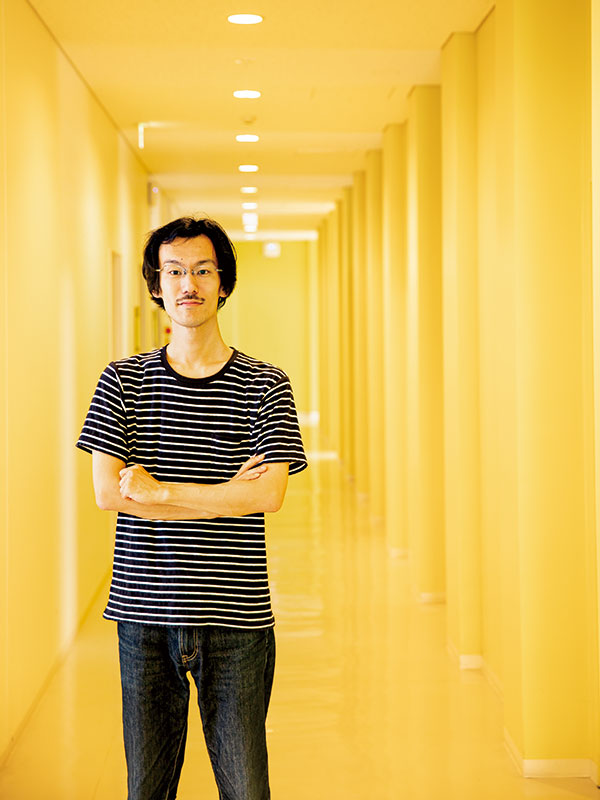Building a bridge between past and future scholarship A humble, mustachioed theorist combines mathematics and physics

UTokyo 30s
Up-and-coming young researchers
Of the approximately 5,800 faculty members active at the University of Tokyo, we have selected nine energetic young researchers in their 30s. In terms of their job titles, there is one professor, two associate professors, one project associate professor, one lecturer, one project lecturer and three research associates. What kind of research are they engaged in day to day? And what is their temperament like? Let’s find out.
| Theoretical Physics (Theory of Elementary Particles) |
Building a bridge between past and future scholarship
A humble, mustachioed theorist combines mathematics and physics
 Yuji Tachikawa Yuji TachikawaProfessor, Kavli Institute for the Physics and Mathematics of the Universe |

Matter can be broken down to molecules, atoms, electrons and ultimately to elementary particles. String theory considers these not as particles, but strings. Professor Yuji Tachikawa, who was appointed a professor at age 36, has built a reputation as a researcher in Quantum Field Theory (QFT), which is related to string theory. So what is QFT? While it is obviously difficult for the general public, it’s similarly difficult for professional mathematicians.
“QFT is a theory that has proven effective in many aspects of physics – it describes the Standard Model of elementary particles and plays important roles in condensed matter theory. Quantum mechanics and general relativity are mathematically well-defined, but not QFT. And yet, its theoretical predictions fit well with experimental results, and it has led to many discoveries in mathematics and physics. I find it interesting.”
Said to be a prodigy from a young age, he participated the International Mathematical Olympiad during high school. The story is also told of how he surprised his fellow students by coming up with a better solution than their teacher’s solution. He ended up choosing to study physics after enrolling in the University of Tokyo’s Faculty of Science.
“Unlike mathematics, which calls for rigor from start to finish, I found that theoretical physics allows more leeway and intuition in play, which is why I felt I was better suited to it.”
Since then, the works of this theoretical physicist at bridging mathematics and physics have achieved worldwide recognition, namely through his role in the discovery of “AGT correspondence” and the phenomenon known as “Mathieu Moonshine.” The former of these was named for the initials of its three discoverers (the other two were Alday and Gaiotto), while the latter takes its name from the context of it being a “ridiculous” discovery (hence “moonshine”) about the Mathieu group M24 in abstract algebra. Both discoveries connected different fields in mathematics and physics, and led to the creation of new directions for research.
“With AGT, I was just asked to verify a conjecture two colleagues of mine came up with when I was at Princeton’s Institute for Advanced Study. It happened that I was the only one capable of doing the necessary calculations. For the other, while discussing with my adviser Professor (Tohru) Eguchi and his former student Professor (Hirosi) Ooguri, I happened to open a numerical table in the Encyclopedic Dictionary of Mathematics and found the same sequence of numbers appear in Ooguri's doctoral dissertation from twenty-five years ago. They were both really just a matter of luck – it’s embarrassing for me to call them achievements.”
Despite the humility of the professor with the unassuming moustache, which he has sported for the past ten years, the fact that his achievements have not simply been lucky accidents is attested by him being honored with a series of prestigious awards, including the Hermann Weyl Prize, the Nishinomiya-Yukawa Memorial Prize and the New Horizons in Physics Prize.
“In the future, I’d like to be able to offer meaningful advice to students as a researcher. That’s the way I feel as someone who has already used up half of his total life as a researcher.”
Tachikawa recalls that as a beginning graduate student, he was studying a subject which was then popular but now is completely forgotten. Had he not changed direction at the suggestion of his late advisor Eguchi, he thinks, he would not be where he is today. On his office bookshelf, the thickly bound and musty spines of physics journals that he rescued as they were about to be discarded seemed evocative of the meaning of the university as a space.
| Q & A | |
|---|---|
| Do you have any hobbies? What do you like to do on your days off? | “Programming for my Mac and my iPhone.” “Taking my little kids to the playground.” |
| We’ve heard you don’t remember your early childhood very well. | “I have a memory of being dragged along by our dog Tom on the day of my Shichi-Go-San ceremony (the traditional rite of passage for children reaching the ages of 7, 5 and 3) [when I was five], but that’s about it.” |
| What are your memories of your undergraduate days, other than study? | “I was in the Piano Club of the university, but I quit in disgust after seeing all the politicking around the club leadership election.” |
| How do you feel about being in your thirties? | “I’m no longer as nimble as I was in my twenties. But hopefully the years would bring wisdom, so I keep working as hard as I can.” |

* This article was originally printed in Tansei 39 (Japanese language only). All information in this article is as of September 2019.






